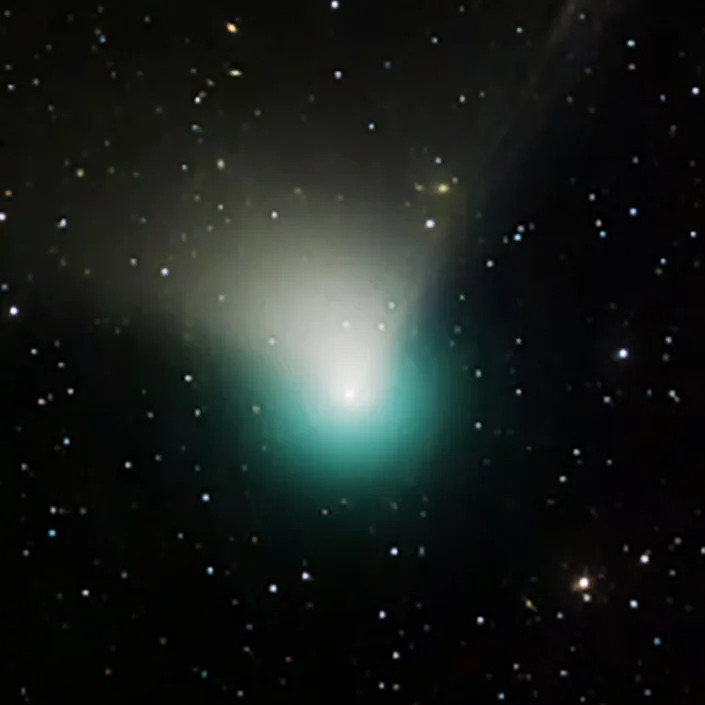Stay Up to Watch the Rare Green Comet Shooting Across night Sky—It Was Last Seen 50,000 Years Ago
Nashia Baker
Thu, January 12, 2023

Comet C/2021 A1 Leonard at dawn over the river.
Anton Petrus / GETTY IMAGES
Beyond Earth's atmosphere, there is an entire cosmos filled with unimaginable discoveries—but every now and then, these phenomenons pass through our night sky on their epic journeys. If you time it right, you'll be able to see one of these monumental celestial sightings this evening: For the first time in 50,000 years, a rare green comet, formally known as C/2022 E3 (ZTF), will shoot across the sky, reports Space. The interstellar object will actually be closest to the sun tonight, but still visible from Earth. Come February 1, the comet will be closer to our planet, a mere 28 million miles away.
Visibility of the once-in-a-lifetime comet will depend on your location and the area's light pollution. Those in the Northern Hemisphere should direct their telescopes towards the northeastern horizon before midnight, around 11:18 p.m. ET, reports People. If you don't have stargazing equipment handy, you can tune into the Virtual Telescope Project's livestream; the broadcast will begin at 11 p.m. ET.
The live feed is scheduled for 14 Jan. 2023, at 04:00 UTC.
Up until this point, the comet has been wedged in the Corona Borealis constellation. Tonight, C/2022 E3 (ZTF) will makes its closest approach to the sun as it moves northwest in space. From there, it will turn west and head towards Earth.
That means tonight isn't your only chance to see the comet—it will get closer to Earth throughout the rest of January and into early February. On January 26 and 27, it will be in the eastern region, close to the Little Dipper. By the evening of February 1, C/2022 E3 (ZTF) will be in its closest proximity to Earth as it moves through the boundaries of the Camelopardalis constellation.
Up until this point, the comet has been wedged in the Corona Borealis constellation. Tonight, C/2022 E3 (ZTF) will makes its closest approach to the sun as it moves northwest in space. From there, it will turn west and head towards Earth.
That means tonight isn't your only chance to see the comet—it will get closer to Earth throughout the rest of January and into early February. On January 26 and 27, it will be in the eastern region, close to the Little Dipper. By the evening of February 1, C/2022 E3 (ZTF) will be in its closest proximity to Earth as it moves through the boundaries of the Camelopardalis constellation.
A rare green comet will zip by Earth this week. Here’s how to see it

Dan Bartlett
Randi Richardson
Thu, January 12, 2023
It's a bird, it's a plane — nope, it's a green comet!
The fireball's official name is Comet C/2022 E3 (ZTF) and it will be visible Jan. 12 with binoculars and perhaps even to the naked eye, NASA announced last month.
The comet was first discovered by astronomers last March and since then it "has brightened substantially" and its layered tails have become more visible, NASA said.
The comet will be its closest to the sun on Jan. 12 and, if its trend of brightening continues, it could become more visible to the eye under dark night skies, NASA said.
How to see the green comet
The comet is currently passing through the northern constellation Corona Borealis, according to NASA. People in the Northern Hemisphere will have a chance to see the comet under the dark sky. But when the comet reaches its closest point to Earth on Feb. 1 or 2, it will be visible in the Southern Hemisphere, NASA said.
To see the green comet, look along the horizon between midnight and dawn, recommends EarthSky, a website dedicated to skywatching and astronomy.
To capture a picture of it, point a camera toward its approximate location in the sky and take long-exposure photos of 20 to 30 seconds, according to EarthSky. That technique will photograph a fuzzy, tailed object even if the comet isn't visible to the naked eye.

Dan Bartlett
Randi Richardson
Thu, January 12, 2023
It's a bird, it's a plane — nope, it's a green comet!
The fireball's official name is Comet C/2022 E3 (ZTF) and it will be visible Jan. 12 with binoculars and perhaps even to the naked eye, NASA announced last month.
The comet was first discovered by astronomers last March and since then it "has brightened substantially" and its layered tails have become more visible, NASA said.
The comet will be its closest to the sun on Jan. 12 and, if its trend of brightening continues, it could become more visible to the eye under dark night skies, NASA said.
How to see the green comet
The comet is currently passing through the northern constellation Corona Borealis, according to NASA. People in the Northern Hemisphere will have a chance to see the comet under the dark sky. But when the comet reaches its closest point to Earth on Feb. 1 or 2, it will be visible in the Southern Hemisphere, NASA said.
To see the green comet, look along the horizon between midnight and dawn, recommends EarthSky, a website dedicated to skywatching and astronomy.
To capture a picture of it, point a camera toward its approximate location in the sky and take long-exposure photos of 20 to 30 seconds, according to EarthSky. That technique will photograph a fuzzy, tailed object even if the comet isn't visible to the naked eye.

No comments:
Post a Comment